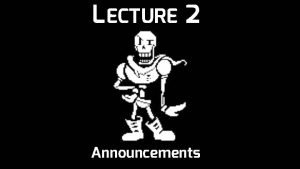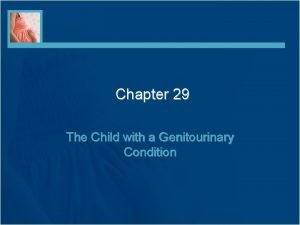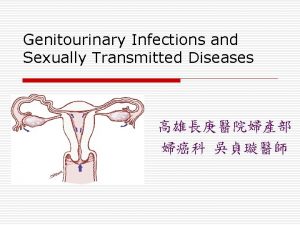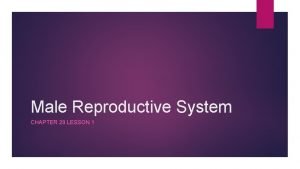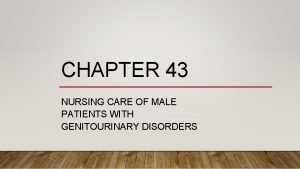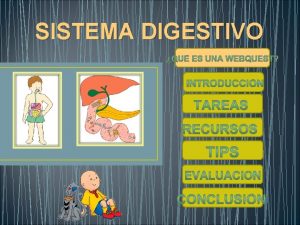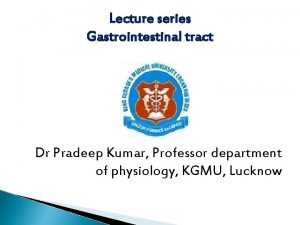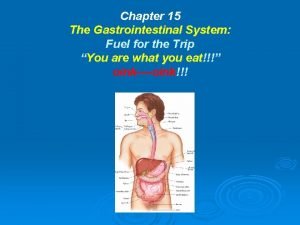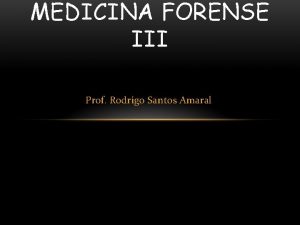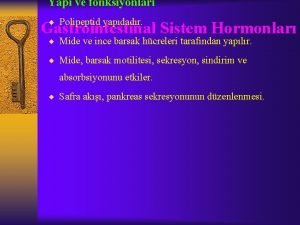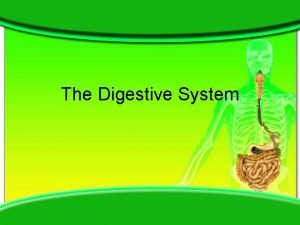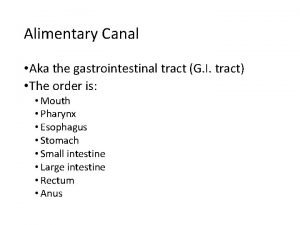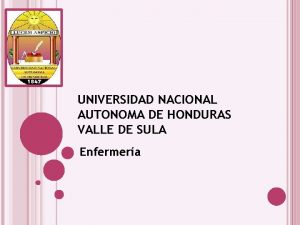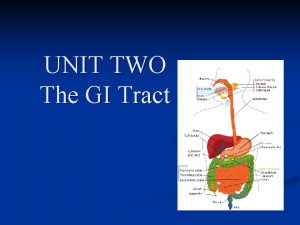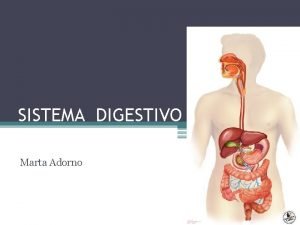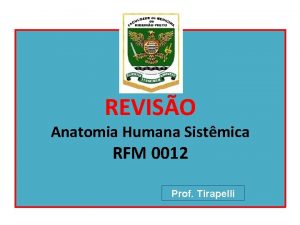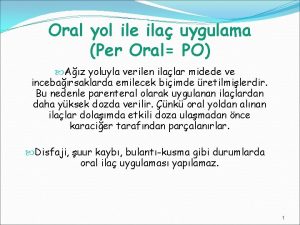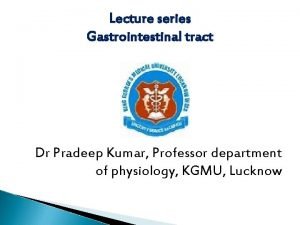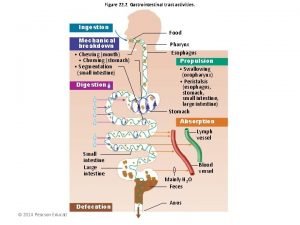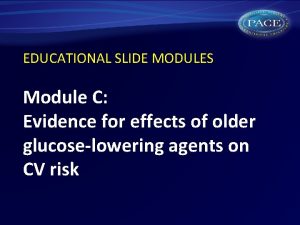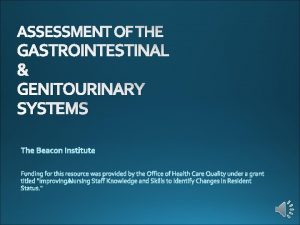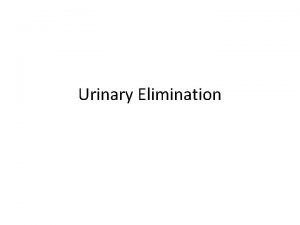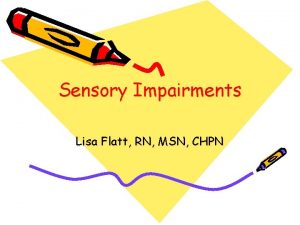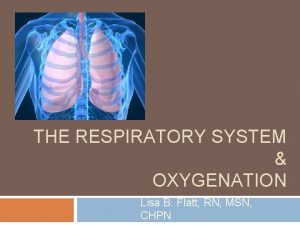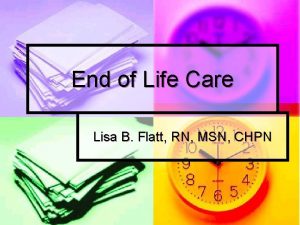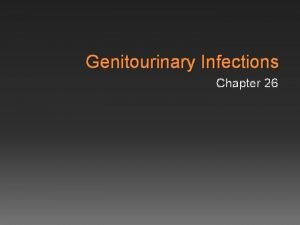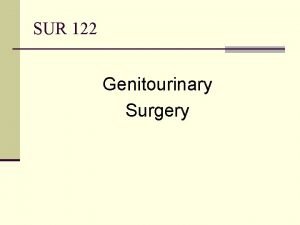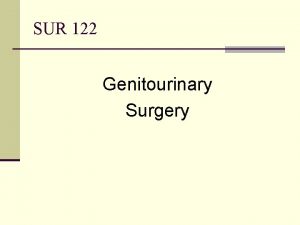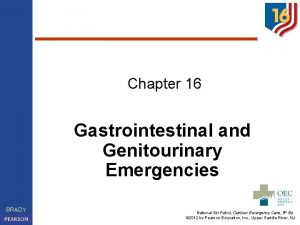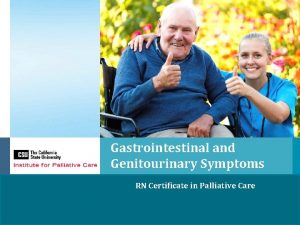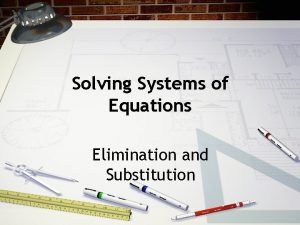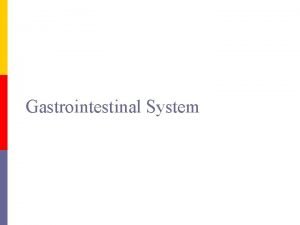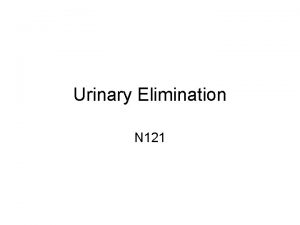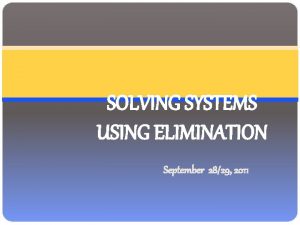ELIMINATION THE GASTROINTESTINAL AND GENITOURINARY SYSTEMS Lisa Flatt

































- Slides: 33

ELIMINATION THE GASTROINTESTINAL AND GENITOURINARY SYSTEMS Lisa Flatt, RN, MSN, CHPN

THE GI TRACT � Lower � The GI tract Large intestine consists of: � ____________ � Sigmoid Colon � Rectum & Anus

QUESTIONS � Where does the majority of bowel absorption take place? ___________ � Can you voluntarily contract and relax the anal sphincters? ___________ � Is the GI tract sterile? _______ � Where is the peritoneum? _____ � Is the peritoneal area sterile? _______

FUN FACTS! � Surgery that involves the bowel is considered “unclean” because the bowel contents and flora contain a large amount of bacteria, that if spread to the peritoneum cause peritonitis. � How would a patient develop peritonitis if they have abdominal surgery – that does not involve the bowel? (like a C-section)

ALL ABOUT POOP � Feces/fecal matter/bowel movement /stool– what are some other terms patients may use? � “Normal stool” is soft, firm, brown and formed � Abnormal consistency: diarrhea, constipated (hard, rock-like), flakey, fulminant, frothy, liquid � “Abnormal” colors: white, yellow, green, red, black, clay-colored, chalk-colored

6 PROBLEMS WITH INTESTINAL ELIMINATION � Constipation � Diarrhea � Fecal impaction � Flatulence – aka fart � Incontinence � Helminths--worms

THE GU TRACT � Kidneys � Ureters � Bladder � Urethra

THE COMPLICATED & CONVOLUTED KIDNEY � Nephron – the functional unit of the kidney � Glomeruli- filters wastes; absorption, resorption and reabsorption of fluids & electrolytes = initial production of urine � Loop of Henle – tubular system in the glomeruli (descending & ascending) that transport the urine, it starts as H 2 O and becomes more acidic as it moves down the loop

QUESTIONS � What is the difference between the male and female urethra? ____________ � What does UTI stand for? ________ � Is a UTI in a male or female considered an emergency and very serious? _____ Why? _______________ � Is the Urinary Tract sterile? ______ � Is urinary function usually decreased as a result of the loss of one kidney? _____

MORE QUESTIONS……. � Define Pyelonephritis _________ � Can upper urinary tract infections be considered life-threatening? _______ � Are lower UTI’s more common in men or women? ___________ � How are they treated? _______ � What are some drug classifications used to treat UTI’s? ______

ALL ABOUT PEE � Urine/Making water/ pee/ wee – can you think of any other names? � “Normal” appearance – clear and light yellow in color � “Abnormal” findings - blood, sediment, mucus or calculi (stones), brown color, foul smelling, sluggish (thick)

QUESTIONS � What can dark colored urine indicate? _______ � What if urine is bloody/red colored? _______ � Who is at the highest risk for urinary retention? ____Why? _________

7 PROBLEMS WITH URINARY ELIMINATION � Retention � Urgency � Frequency � Incontinence � Nocturia � Polyuria � Enuresis

FACTORS THAT AFFECT GI AND GU ELIMINATION � Sex � Age & Developmental Level � Individual Preferences and patterns (dietary habits) � Physical condition � Cultural, spiritual and/or religious factors � Socioeconomic factors � Environmental factors � Psychological factors

BABY POOP – AND PEE � Meconium – dark green sticky mucousyprotects bowel in utero � Breast – yellow and seedy (colostorum) � Formula – brown, formed (poop less)

CHILDREN ELIMINATION � Brown, formed and regular � Potty trained � Regression – stressors, new babies in the house � Loss of some function - activity

ADULT ELIMINATION � � � � � Soft, brown Incontinent Constipated Peristalsis – slow down (gastroparesis, biopsy) Mental – obsessed Regular – for that person Dependent on laxatives BPH- retention, difficulty start and stop Neurogenic bladder – urinary retention Caffeine is a cathartic

FACTORS AFFECTION ELIMINATION � How do the various stages of life affect elimination? _____________ � What affect can activity have on intestinal elimination? _____________ � What affect does physical condition have on intestinal elimination? _________ � What affect does diet have on intestinal elimination? _____________

IMPLICATIONS…… � � � � � PAGE 35 -39 Activity, diet, fluids, fibers all affect bowel status Using laxatives, enemas, suppositories can lead to inability to poop on own Diuretics – rid body of excess fluid, increase urination Stool softeners – make soft NOT laxatives Sleep - regularity Stress – diarrhea or constipation Abdominal and pelvic muscle tone - continence Catheterization – sphincter muscle damage – leaking or retention Rectal tube – for fecal elimination (diarrhea) – other systems Depression and other mental illness

NURSING ASSESSMENT OF THE GI SYSTEM � How often do you have a BM? � What does it look like? � Do you use laxatives regularly? Stool softeners? � When was your LBM? � Do you pass gas? � Do you stomach pain? Does your abdomen feel hard or distended? � Bowel sounds in all quadrants?

NURSING ASSESSMENT OF THE GU SYSTEM � How often do you urinate? � Do you pee at night? � Do you have pain with urination? � Do you dribble/leak? Incontinent? � What color is it? � What does it smell like? Is it foul? � Do you see mucus, stones or sediment? Milky? � Do you see any red? Blood streaks?

PROBLEM Constipation Diarrhea Fecal impaction Flatulence Incontinence Helminths WHAT TO DO Fluids, laxatives, stool softeners, activity Clear liquids, fiber, medications, stool sample Disimpact, enema, suppository Beano, fiber Attends, Depends, bowel and bladder program, muscle strengthening, Kegel’s Kill the worms! PROBLEMS, PROBLEMS

PROBLEM WHAT TO DO Frequency Nocturia Urgency Dysuria Enuresis – define length of dry time Incontinence Retention Polyuria PROBLEMS, B&B program, UTI/labs/tests B&B program, decrease fluids prior to sleeping B&B program, UTI/labs/tests Labs/tests B&B program, Kegel’s Labs/tests/BPH Asses fluids, diabetes, PROBLEMS, labs/tests/UTI PROBLEMS

DISEASE/CONDITION UTI – BPH – Incontinence – Functional Overflow Reflex Total CAUSE AND TREATMENT Retention – Urinary suppression - Urinary Tract Infection – bacteria or fungus Prostate, aging process Varies with type BPH, sphincter valve issues, catatonia (mental issues), spinal cord injuries Kidneys no longer make urine DISEASES/CONDITIONS OF THE URINARY TRACT

OTHER STUFFS Disease: Cancer & chemotherapy use– degradation of mucosal lining, diarrhea, blood, poor absorption, constipation � Diarrhea **8 or more liquid stools in one day* � Parasites, worms, medications, foods, stress, diet, IBS, Chron’s, CDIFF!!!!! � Incontinence – drugs, sphincter control, diseases (tumors), stress, abuse, sneezing (haha) � Neurogenic bladder – full bladder does not stimulate the need to pee �

URINARY DEVICES AND INTERVENTIONS � Urostomy � Stents � Foley catheters � Coude catheters � Condom catheters � Urine pouches – U bags – Pee Pouches � Straight catheterization � Suprapubic catheters

GI DEVICES AND INTERVENTIONS Colostomy � Ileostomoy � Jejunostomy � Gastrostomy tube � Flexible Sigmoidoscopy � Upper GI � Lower GI � Rectal Tubes � Bowel Management Systems �

ENEMAS � Cleansing enemas “Fleets” � Irrigation enemas – colonic irrigation � Medicated enemas � Carminative enema - flatus expellation enema � Oil retention enema

OUTPUT � Less than 30 ml of urine per hour is decreased � Monitor urine output every 6 -8 -12 -24 hours � Record BM’s � Emesis � NG Output � Liquid stool � Bed sheet soaked in perspiration

INTAKE � Fluids � Foods with high water � IV and PO Fluids � Tube feedings � Free water with tube feedings

TESTS- GI AND GU � � � � BUN and Creatinine Urinary p. H Ketones Specific Gravity Urinalysis Urine culture and sensitivity Occult Blood Urobilinogen Stool tested for wormies, cdiff, bacteria, ova and parasites Xrays/CT scans/Ultrasounds/Intravenous pyelogram IVP/MRI Cystoscopy Pyelogram

THE NURSING PROCESS � Assessment – Analyze � Nursing Diagnosis � Planning � Implementing � Evaluating

SCENARIO � 74 y/o man, daily laxative use, constipated history, medications: lasix, metformin, cholesterol, metoprolol, poor diet � � � Analyze: hx constipation, BP, diabetic, cholesterol issues, diet issues, decreased activity, laxative abuse Nursing Dx: Constipation related to daily laxative usage Plan: Client will: increase activity by walking 4 blocks daily, decrease laxative use to 3 times weekly, follow diet as recommended by dietician, increase fluids to 2 liters per day, use stool softeners daily, increase fiber intake to 20 gm/day, Implement: Obtain dietary consult; Obtain PT/OT consult; Instruct on how to measure fluid intake and healthy fluid options; Instruct on s/s of constipation; instruct on s/s normal BM; instruct of side effects of medications including: lasix, laxatives and other medications; instruct on daily walk; instruct on keeping 7 day –diet-fluid-exercise-blood sugar log -- all accomplished in two weeks Evaluation: Patient & family verbalizes side effects of laxative use and other medications; return demonstration of exercises; Shows 7 day log and able to analyze areas that are strengths and weaknesses; compliant with diabetic diet and diet as recommended by dietician; verbalizes healthy fluid options; verbalize free of s/s constipation
 Pretrajectory
Pretrajectory Bloody pee
Bloody pee Emily flatt
Emily flatt Matthew flatt
Matthew flatt Gauss vs gauss jordan
Gauss vs gauss jordan Chapter 29 the child with a genitourinary condition
Chapter 29 the child with a genitourinary condition Chapter 29 the child with a genitourinary condition
Chapter 29 the child with a genitourinary condition Genitourinary & stds
Genitourinary & stds Male genitourinary anatomy
Male genitourinary anatomy Nursing diagnosis for undescended testis
Nursing diagnosis for undescended testis Emt chapter 18 gastrointestinal and urologic emergencies
Emt chapter 18 gastrointestinal and urologic emergencies Embriologia del sistema gastrointestinal
Embriologia del sistema gastrointestinal Gastrointestinal tract
Gastrointestinal tract Gastrointestinal tract
Gastrointestinal tract Chapter 15 the gastrointestinal system
Chapter 15 the gastrointestinal system Gastrointestinal hormones
Gastrointestinal hormones Sigid djuniawan
Sigid djuniawan Docimasia gastrointestinal
Docimasia gastrointestinal Kolesistokinin
Kolesistokinin Gastrointestinal medical terminology breakdown
Gastrointestinal medical terminology breakdown Nutrition focused physical findings
Nutrition focused physical findings Embryo folding
Embryo folding Composition of stomach
Composition of stomach Motilidad gastrointestinal
Motilidad gastrointestinal Upper gi bleeding management
Upper gi bleeding management Função intestino delgado
Função intestino delgado Doença gastrointestinal
Doença gastrointestinal Gastrointestinal disease
Gastrointestinal disease Peroral ilaç uygulama
Peroral ilaç uygulama Intestinal villus
Intestinal villus Gastrointestinal
Gastrointestinal Why does metformin cause diarrhea
Why does metformin cause diarrhea Digestive system
Digestive system Nursing care for gastrointestinal disorders
Nursing care for gastrointestinal disorders



